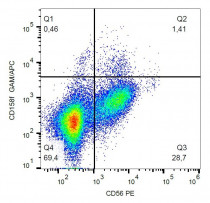ARG42255
anti-CD158f / KIR2DL5 antibody [UP-R1]
anti-CD158f / KIR2DL5 antibody [UP-R1] for Flow cytometry,ICC/IF and Human
Overview
| Product Description | Mouse Monoclonal antibody [UP-R1] recognizes CD158f / KIR2DL5 |
|---|---|
| Tested Reactivity | Hu |
| Tested Application | FACS, ICC/IF |
| Specificity | The mouse monoclonal antibody UP-R1 recognizes an extracellular epitope on CD158f (KIR2DL5), a 60 kDa glycoprotein serving as a HLA class I ligand, and mainly expressed on a subset of NK cells and a small population of T cells. Its expression is highly polymorphic between individuals. |
| Host | Mouse |
| Clonality | Monoclonal |
| Clone | UP-R1 |
| Isotype | IgG1, kappa |
| Target Name | CD158f / KIR2DL5 |
| Antigen Species | Human |
| Immunogen | Human CD158f-Ig fusion protein. |
| Conjugation | Un-conjugated |
| Alternate Names | CD antigen CD158f1; KIR2DL5.3; KIR2DL5.1; Killer cell immunoglobulin-like receptor 2DL5A; KIR2DL5; CD158F |
Application Instructions
| Application Suggestion |
|
||||||
|---|---|---|---|---|---|---|---|
| Application Note | * The dilutions indicate recommended starting dilutions and the optimal dilutions or concentrations should be determined by the scientist. |
Properties
| Form | Liquid |
|---|---|
| Purification | Purification with Protein A. |
| Buffer | PBS and 15 mM Sodium azide. |
| Preservative | 15 mM Sodium azide |
| Concentration | 1 mg/ml |
| Storage Instruction | For continuous use, store undiluted antibody at 2-8°C for up to a week. For long-term storage, aliquot and store at -20°C or below. Storage in frost free freezers is not recommended. Avoid repeated freeze/thaw cycles. Suggest spin the vial prior to opening. The antibody solution should be gently mixed before use. |
| Note | For laboratory research only, not for drug, diagnostic or other use. |
Bioinformation
| Database Links |
Swiss-port # Q8N109 Human Killer cell immunoglobulin-like receptor 2DL5A |
|---|---|
| Gene Symbol | KIR2DL5A |
| Gene Full Name | killer cell immunoglobulin-like receptor, two domains, long cytoplasmic tail, 5A |
| Background | Killer cell immunoglobulin-like receptors (KIRs) are transmembrane glycoproteins expressed by natural killer cells and subsets of T cells. The KIR genes are polymorphic and highly homologous and they are found in a cluster on chromosome 19q13.4 within the 1 Mb leukocyte receptor complex (LRC). The gene content of the KIR gene cluster varies among haplotypes, although several "framework" genes are found in all haplotypes (KIR3DL3, KIR3DP1, KIR3DL4, KIR3DL2). The KIR proteins are classified by the number of extracellular immunoglobulin domains (2D or 3D) and by whether they have a long (L) or short (S) cytoplasmic domain. KIR proteins with the long cytoplasmic domain transduce inhibitory signals upon ligand binding via an immune tyrosine-based inhibitory motif (ITIM), while KIR proteins with the short cytoplasmic domain lack the ITIM motif and instead associate with the TYRO protein tyrosine kinase binding protein to transduce activating signals. The ligands for several KIR proteins are subsets of HLA class I molecules; thus, KIR proteins are thought to play an important role in regulation of the immune response. [provided by RefSeq, Jul 2008] |
| Function | Receptor on natural killer (NK) cells for HLA-C alleles. Inhibits the activity of NK cells thus preventing cell lysis. [UniProt] |
| Cellular Localization | Cell membrane; Single-pass type I membrane protein. [UniProt] |
| Calculated MW | 41 kDa |
Images (1) Click the Picture to Zoom In






